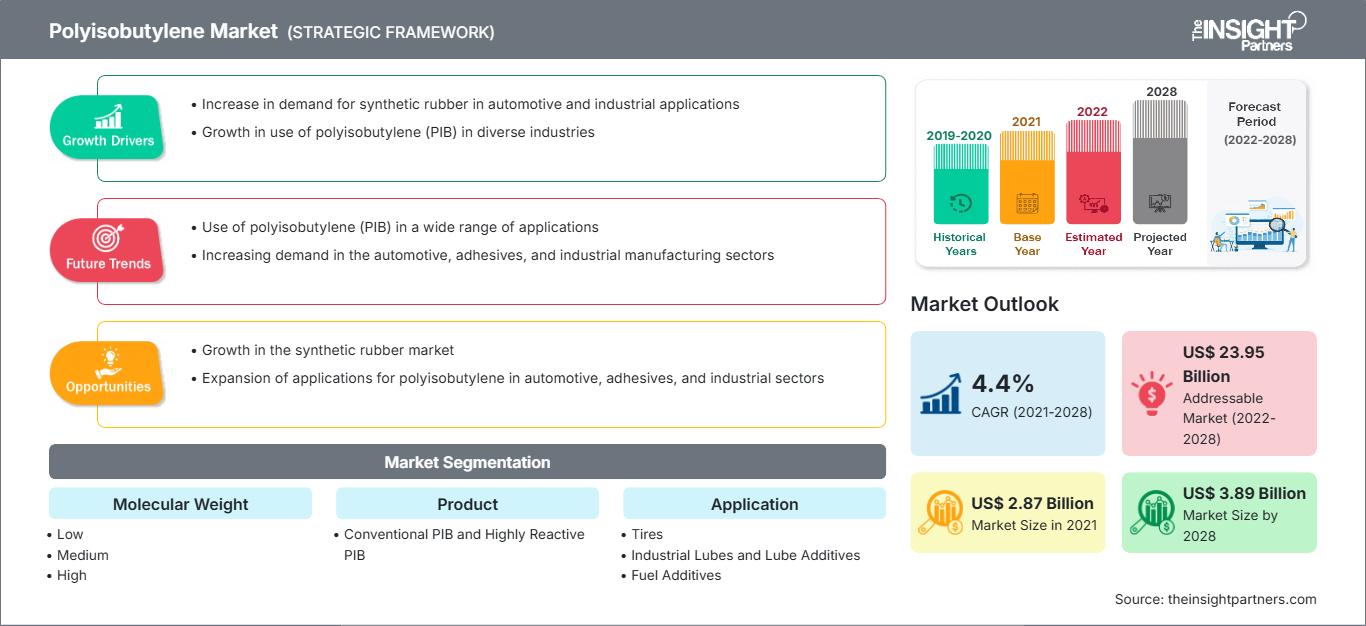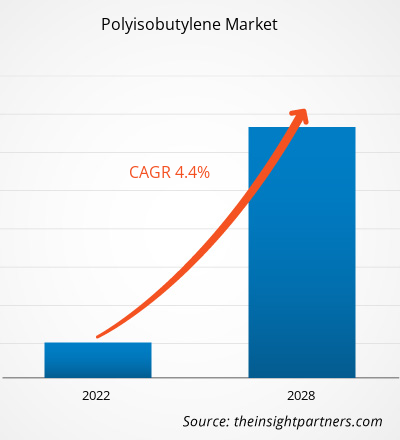[Informe de investigación] El mercado de poliisobutileno se valoró en US$ 2.871,14 millones en 2021 y se proyecta que alcance los US$ 3.891,16 millones para 2028; se espera que crezca a una CAGR del 4,4% de 2021 a 2028.
El poliisobutileno (PIB) es un elastómero o caucho sintético. Por peso molecular, el mercado se segmenta en bajo, medio y alto. Es un líquido viscoso, versátil, no tóxico y blanco como el agua. El poliisobutileno puede aumentar la adherencia, proporcionar repelencia al agua, mejorar el índice de viscosidad y proporcionar un excelente aislamiento eléctrico.
En 2020, Norteamérica registró la mayor participación en los ingresos del mercado mundial de poliisobutileno. La creciente demanda de diversas aplicaciones, como transporte, agroquímicos, electricidad y adhesivos, impulsa el crecimiento del mercado en Norteamérica. El poliisobutileno se utiliza cada vez más en las industrias del transporte, la alimentación y la construcción, ya que ofrece baja permeabilidad a los gases, excelente resistencia a la tracción, alta resistencia química y mayor rigidez.
Obtendrá personalización en cualquier informe, sin cargo, incluidas partes de este informe o análisis a nivel de país, paquete de datos de Excel, así como también grandes ofertas y descuentos para empresas emergentes y universidades.
Mercado de poliisobutileno: Perspectivas estratégicas

- Obtenga las principales tendencias clave del mercado de este informe.Esta muestra GRATUITA incluirá análisis de datos, desde tendencias del mercado hasta estimaciones y pronósticos.
Impacto de la pandemia de COVID-19 en el mercado del poliisobutileno
La pandemia de COVID-19 alteró drásticamente la situación del sector químico y de materiales e impactó negativamente el crecimiento del mercado del poliisobutileno. La industria mundial de productos químicos y materiales es una de las principales que ha sufrido graves interrupciones debido a la pandemia, como interrupciones en la cadena de suministro, cancelaciones de eventos tecnológicos y cierres de oficinas. Las prohibiciones de viaje impuestas por países de Europa, Asia y Norteamérica están afectando las oportunidades de colaboración y asociación empresarial. Se prevé que todos estos factores afecten negativamente a la industria electrónica y de productos químicos y materiales, lo que obstaculiza el crecimiento de diversos mercados relacionados con estas industrias. Sin embargo, a medida que las economías planean reactivar sus operaciones, se espera que la demanda de poliisobutileno aumente a nivel mundial. La demanda de poliisobutileno de los sectores de lubricantes industriales y aditivos para lubricantes ha comenzado a aumentar con la reanudación de las actividades comerciales y el levantamiento de las medidas de confinamiento a nivel mundial. Perspectivas del mercado: La industria automotriz impulsará el crecimiento del mercado durante el período de pronóstico.
Para la industria automotriz, el rendimiento de los motores para sus funciones diarias es fundamental. Esta industria ha sido un mercado clave para diversos tipos de aditivos para combustibles durante muchos años. La cuota de mercado de los automóviles ha sido continuamente superior a la de otros segmentos de aditivos para combustibles debido a la falta de alternativas eficientes a los combustibles fósiles y al crecimiento de la clase media. La importancia relativa de la aviación para los aditivos para combustibles ha aumentado en los últimos años, lo que ha impulsado la demanda de poliisobutileno.polyisobutylene.
Perspectivas de la aplicación
Según la aplicación, el mercado global de poliisobutileno está segmentado en neumáticos, lubricantes industriales y aditivos para lubricantes, aditivos para combustibles, adhesivos y selladores, y otros. El segmento de lubricantes industriales y aditivos para lubricantes tuvo la mayor participación del mercado en 2020. El poliisobutileno (PIB) reacciona con anhídrido maleico para formar anhídrido poliisobutenilsuccínico (PIBSA), un componente básico para dispersantes en aceites lubricantes y detergentes en combustibles. Su otra variante, la poliisobutileno-succinimida (PIBSI), derivada del poliisobutileno (PIB), actúa como un emulsionante antioxidante en fluidos solubles para metalurgia y como componente básico de aditivos para lubricantes. El PIB también se quema de forma más limpia, lo que lo hace ideal para su uso en aceites para motores de dos tiempos y aplicaciones marinas donde los lubricantes están sujetos a gases agresivos de escape de grandes motores diésel.
BASF SE, Braskem SA, Daelim Industrial Petrochemical Division, Ineos AG, Infineum International Limited, Kothari Petrochemicals, Sibur Holding PJSC, Kemat Polybutenes, The Lubrizol Corporation y TPC Group se encuentran entre los actores clave del mercado global del poliisobutileno. Los actores que operan en este mercado están altamente enfocados en desarrollar productos innovadores y de alta calidad para satisfacer las necesidades de los clientes.
Perspectivas regionales del mercado del poliisobutileno
Los analistas de The Insight Partners han explicado detalladamente las tendencias regionales y los factores que influyen en el mercado del poliisobutileno durante el período de pronóstico. Esta sección también analiza los segmentos y la geografía del mercado del poliisobutileno en América del Norte, Europa, Asia Pacífico, Oriente Medio y África, y América del Sur y Central.
Alcance del informe de mercado de poliisobutileno
| Atributo del informe | Detalles |
|---|---|
| Tamaño del mercado en 2021 | US$ 2.87 mil millones |
| Tamaño del mercado en 2028 | US$ 3.89 mil millones |
| CAGR global (2021-2028) | 4,4% |
| Datos históricos | 2019-2020 |
| Período de pronóstico | 2022-2028 |
| Segmentos cubiertos | Por peso molecular
|
| Regiones y países cubiertos | América del norte
|
| Líderes del mercado y perfiles de empresas clave |
|
Densidad de actores del mercado de poliisobutileno: comprensión de su impacto en la dinámica empresarial
El mercado del poliisobutileno está creciendo rápidamente, impulsado por la creciente demanda del usuario final debido a factores como la evolución de las preferencias de los consumidores, los avances tecnológicos y un mayor conocimiento de los beneficios del producto. A medida que aumenta la demanda, las empresas amplían su oferta, innovan para satisfacer las necesidades de los consumidores y aprovechan las tendencias emergentes, lo que impulsa aún más el crecimiento del mercado.

- Obtenga una descripción general de los principales actores clave del mercado de poliisobutileno
Informe destacado
- Tendencias progresivas de la industria en el mercado de poliisobutileno para ayudar a los actores a desarrollar estrategias efectivas a largo plazo.
- Estrategias de crecimiento empresarial adoptadas por los mercados desarrollados y en desarrollo
- Análisis cuantitativo del mercado de poliisobutileno de 2019 a 2028
- Estimación de la demanda mundial de poliisobutileno
- Análisis de las cinco fuerzas de Porter para ilustrar la eficacia de los compradores y proveedores que operan en la industria
- Desarrollos recientes para comprender el escenario del mercado competitivo
- Tendencias y perspectivas del mercado, así como factores que impulsan y restringen el crecimiento del mercado de poliisobutileno
- Asistencia en el proceso de toma de decisiones destacando las estrategias de mercado que sustentan el interés comercial, lo que conduce al crecimiento del mercado.
- El tamaño del mercado de poliisobutileno en varios nodos
- Descripción detallada y segmentación del mercado, así como la dinámica de la industria del poliisobutileno.
- Tamaño del mercado de poliisobutileno en diversas regiones con prometedoras oportunidades de crecimiento
Mercado de poliisobutileno
Por peso molecular
- Bajo
- Medio
- Alto
- Producto
- PIB convencional
- PIB altamente reactivo
Solicitud
- Llantas
- Lubricantes industriales y aditivos para lubricantes
- Aditivos para combustible
- Adhesivos y selladores
- Otros
Industria de uso final
- Industrial
- Alimento
- Otros
Perfiles de empresas
- BASF SE
- Braskem S.A.
- División Petroquímica Industrial de Daelim
- Ineos AG
- Infineum Internacional Limitada.
- Polibutenos Kemat
- Petroquímica Kothari
- Sibur Holding PJSC
- La Corporación Lubrizol
- Grupo TPC
- Análisis histórico (2 años), año base, pronóstico (7 años) con CAGR
- Análisis PEST y FODA
- Tamaño del mercado, valor/volumen: global, regional y nacional
- Industria y panorama competitivo
- Conjunto de datos de Excel
Informes recientes
Testimonios
Razón para comprar
- Toma de decisiones informada
- Comprensión de la dinámica del mercado
- Análisis competitivo
- Información sobre clientes
- Pronósticos del mercado
- Mitigación de riesgos
- Planificación estratégica
- Justificación de la inversión
- Identificación de mercados emergentes
- Mejora de las estrategias de marketing
- Impulso de la eficiencia operativa
- Alineación con las tendencias regulatorias






















 Obtenga una muestra gratuita para - Mercado de poliisobutileno
Obtenga una muestra gratuita para - Mercado de poliisobutileno